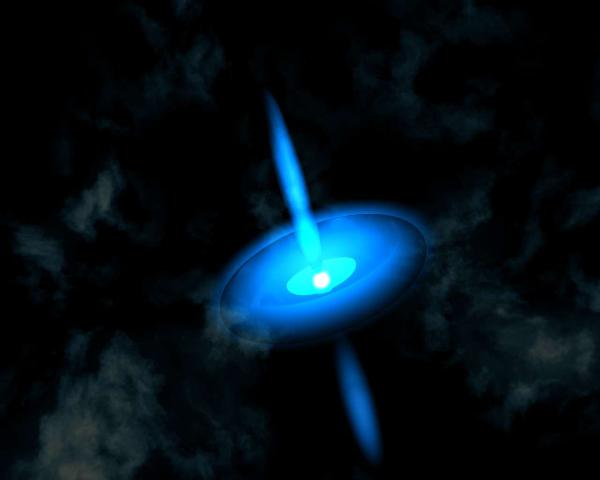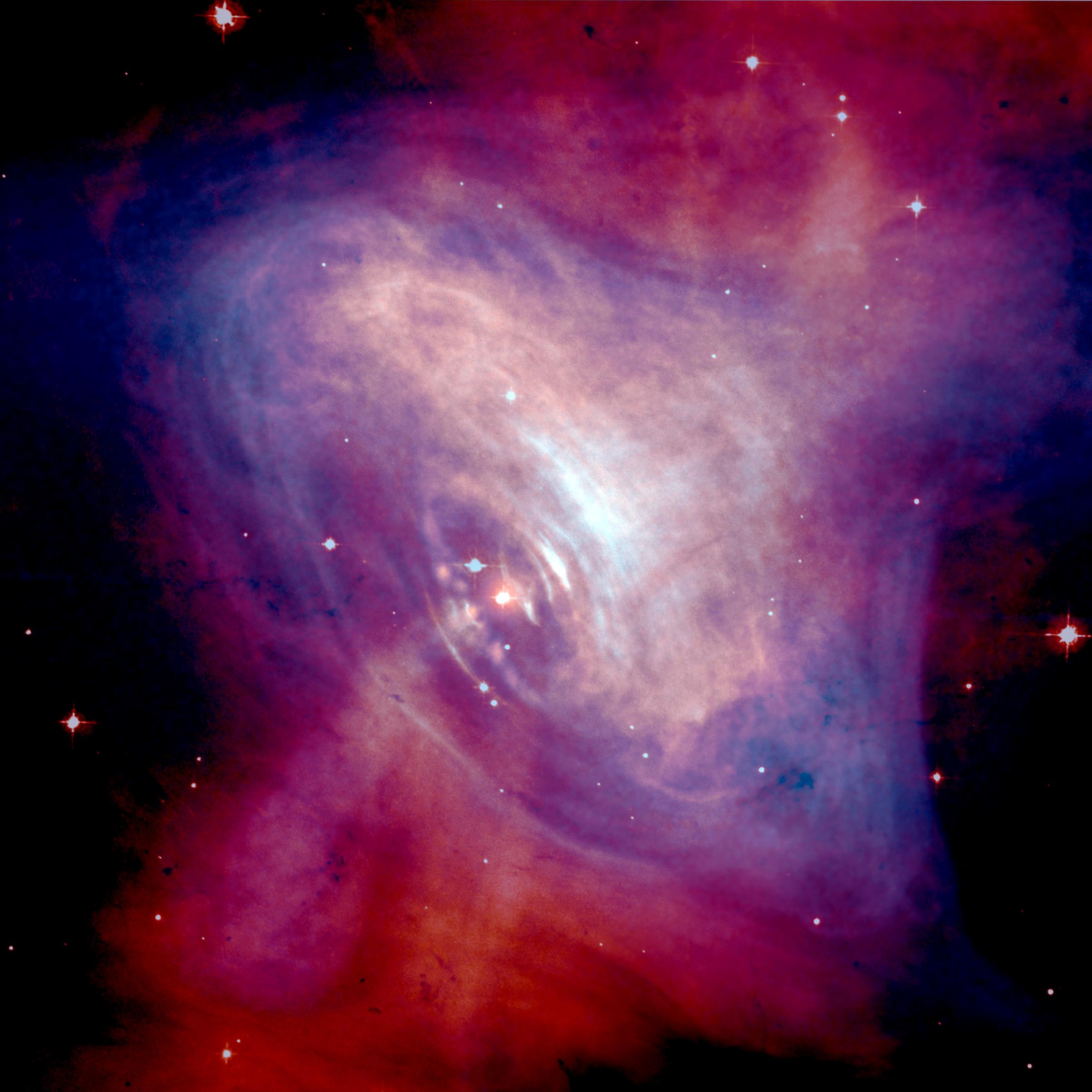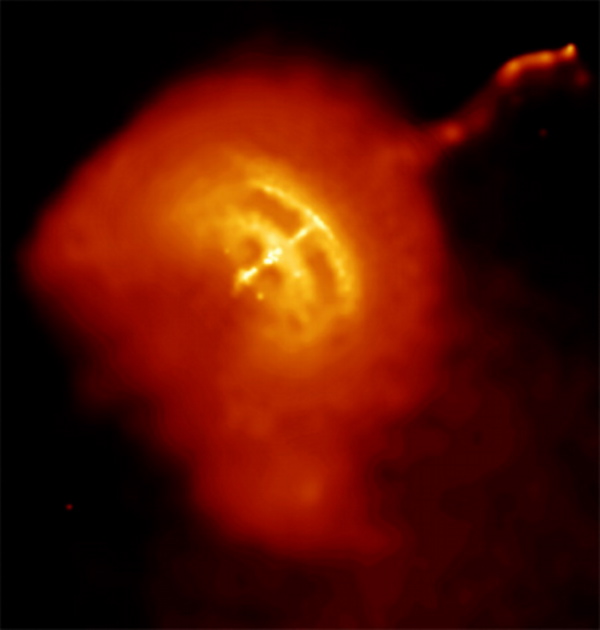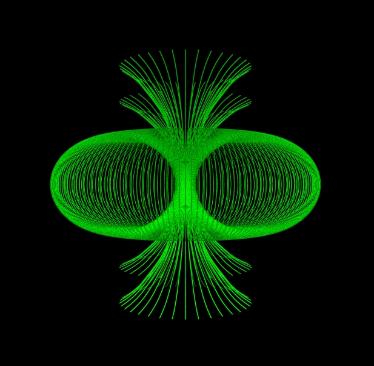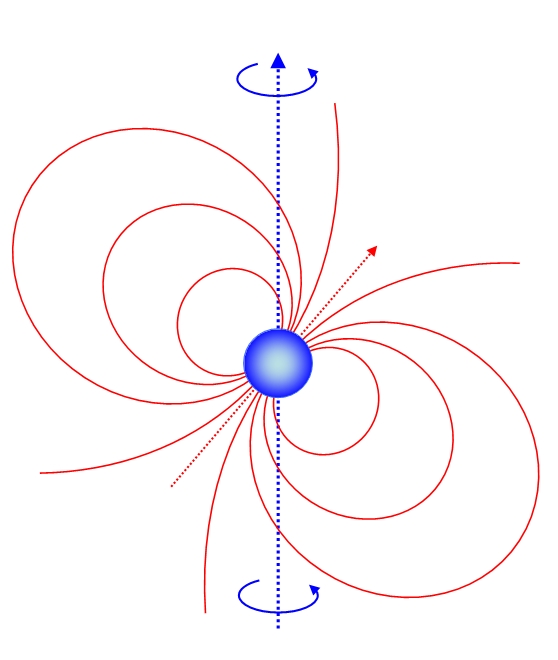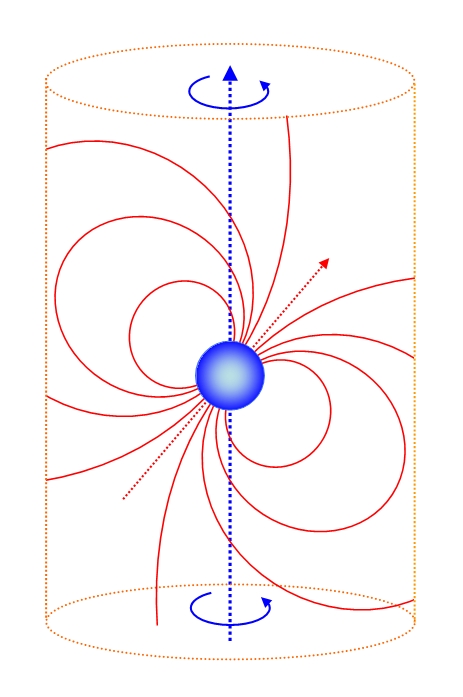Pulsars
Pulsars
are rapidly rotating neutron stars
A
neutron
star
is all that remains of the core of large stars within a certain mass
range, when those stars end their lives in a supernova explosion. If the remnant
of a dead star is left with less than about 1.44 solar masses then
it becomes a white dwarf, and if it is left with more than about 5
solar masses it becomes a black hole. Stellar remnants with an
intermediate mass of 1.35 to 2.1 solar masses are too heavy to exist
as white dwarfs, but too light (strictly - not dense enough) to
become black holes and these remnants form a range of bizarre
objects called neutron stars (some possibly also form strange stars or quark
stars).
Stars that begin with less than 11 solar masses (including the Sun)
are generally too small to undergo a supernova explosion but may
lose up to 90% of their mass as planetary nebulae when they die and the
remnant will only have sufficient mass to form a white dwarf. Larger
stars will usually undergo a supernova explosion and their cores
will form neutron stars or even black holes.
A star spends most of its active life on the main sequence, during which it burns
hydrogen fuel in its core by nuclear
fusion.
Nuclear fusion builds heavier elements from lighter ones - first
stars burn hydrogen by fusing it into heavier helium, then helium is
burnt to produce carbon, nitrogen and oxygen. These elements are in
turn burnt to produce heavier elements, all the way up to iron. How
far a star gets along this process will depend upon its mass. A star
the size of the Sun will end up with mostly carbon and oxygen in its
core, but heavier stars will synthesise heavier elements in their
cores. As the star runs out of hydrogen in its core and starts
to convert helium into heavier elements, then it will undergo a
series of changes as it expands into first a red giant and if it is massive
enough into a red supergiant. Very massive stars
(heavier than 11 solar masses) will end up with lots of iron in
their cores. Here they encounter problems, because iron is too
stable to be burnt or fused into heavier elements and nuclear fusion
in the core stops. Without its energy source the core cools and
without thermal pressure to hold it up, it implodes catastrophically
under its own gravity. The core shrinks and shock waves explode away
the outer layers of the star as a supernova explosion. Supernovae are so bright
that they may outshine an entire galaxy of a billion stars.
If the shrinking core has insufficient mass to become a black hole
then the core stops shrinking once it becomes a neutron star. The
neutron star core remnant is often thrown out by the explosion and sent hurtling across
space at immense speeds
(typically at several million kph!). Typically, they also spin at great speeds, typically several
rotations per second. This rapid rotation occurs as a result of
their dramatic shrinkage when they are born. When a spinning
ice-skater pulls in their arms they spin faster, due to what we call
the conservation of angular momentum. Similarly, when the core of a
slowly rotating star shrinks, the speed of rotation increases
dramatically. A rotating neutron star is called a pulsar.
Neutron stars are typically 10-20 kilometers in radius (the heavier
ones are smaller!) but because they weigh twice as much as the Sun,
they are extremely dense. A
tea spoonful of neutron star matter would weigh several billion
tonnes! This
immense density means that neutron stars have immense gravitational
fields. If an average man could stand on the surface of a neutron
star then he would weigh about 100 billion tonnes! Clearly he would
be squashed to almost nothing, instantly.
Pulsars are so-called because they are seen as pulsating stars. They
send out beams
of intense radio waves
and visible light and as they rotate so the beams sweep in and out
of view, rather like a lighthouse. Thus, pulsars are seen to pulse,
typically several times a second. In addition to these radio beams,
the intense magnetic fields characteristic of neutron stars
accelerate sub-atomic particles and may send out
jets of
electrons and anti-electrons (antimatter) from its poles. These jets
travel at about half the speed of light, or at about 150 thousand
kilometres per second! Indeed if they travelled any slower then they
would not be able to escape the immense gravitational field of the
pulsar. Intense winds of radiation drive out from the pulsars
equator and where they hit the surrounding interstellar gas they
form luminous shock boundaries which form a bright
torus-like
structure around the star's equator, as shown in the illustration
above.
Although neutron stars are very hot at birth, they have no source of
fuel for nuclear fusion, and yet they emit tremendous amounts of
energy, such as the radio beams that we detect. Where this energy
comes from is still being investigated, but there appear to be three
types of pulsar depending upon their principal energy source:
1. Rotation-powered
pulsars,
like the one shown above, convert their rotational energy into the
radiation that we detect. E.g. The crab pulsar. These pulsars slow
down over time very slowly - a pulsar initially rotating once per
second will rotate at about 1.03 revolutions per second one million
years later. Every so often the pulsar glitches and speed up slightly for
a while, before continuing to slow down again.
2. Accretion-powered
pulsars
orbit a companion star in a close orbit and they may pull material
off their companion star and form an accretion disc of material around them
(similar to many white dwarfs). This disc material slowly spirals
onto the neutron star with the release of intense X-ray radiation
(most X-ray pulsars fall into this category). The in-falling or
accreting material may spin-up the neutron star, causing it to
rotate faster. Eventually such pulsars may rotate more than 1000
times each second (!) and are called millisecond
pulsars.
3. Magnetars. Magnetars are neutron
stars with exceptionally strong magnetic fields. The slow decay of
these magnetic fields powers the radiation emission.
Above:
the Crab Nebula Pulsar. Below: the Vela Pulsar. Both images were
taken using NASA's Chandra X-Ray observatory. Images courtesy of
NASA. Note the jets and torus of accreting matter.
External link: Chandra X-Ray Observatory.
The Crab Pulsar rotates once every 33.5 milliseconds. It is the remnant of supernova SN 1054, recorded in China in the year 1054. It is 2000 pc from Earth (1 pc, 1 parsec = 3.26 light years).
Magnetic Fields, Rotation and Periodic Radio-Beaming
A neutron star acts like a giant spinning bar magnet. The magnetic axis is misaligned with the rotation axis or axis of spin of the star. The magnetic field lines form a torus around the star, which is perpendicular to the direction of the magnetic field vector (blue arrow) which traps charged particles which corotate with the neutron star. Those magnetic field lines that cross the light cylinder (the edges of which are shown by the dotted lines) are unable to corotate with the star, since they would have to exceed the speed of light to do so. Instead of returning to the star's surface, they remain open and cross the light cylinder (and join the radiation field at large distances from the pulsar). Charged particles (electrons and protons) stream out along these field lines, generating radio-waves by synchrotron emission as the particles are accelerated to speeds close to the speed of light. (This streaming of particles may generate the jets, although accretion of matter onto the neutron star may also generate these jets). The misalignment of magnetic and rotational axes causes a periodic pulse to be detected at a distance, as the radio-jets trace out a cone as the star rotates, causing the signal to peek when it is beamed directly at a distant observer at periodic intervals.
A Pov-Ray representation of the magnetic field around a pulsar.
The precise mechanism of formation of the polar jets is not fully understood, but is thought to involve open magnetic field lines. As the magnetic field lines leave one pole and reconnect at the other, charged particles of plasma are accelerated along these field lines. These plasma streams co-rotate with the pulsar. However, the outer field lines are unable to reconnect with the other pole, since this would require the magnetic field to travel faster than light, which it can not do. Thus there is a maximum distance, outlined by the light cylinder beyond which field lines can not reconnect. Particles accelerating along these open field lines may leave the system altogether. (Note that as magnetic field lines direct plasma, very fast moving plasma can also direct the field lines). These open field lines are directed as funnels emanating from the pulsar's poles and account for the observed radio beams, though additional focusing of the beams may be required. An accretion disc or torus around the pulsar possibly also helps to funnel the beams from the poles.
The particles beamed away from the open field lines may also carry angular momentum away with them (especially if the angle between the magnetic axis (red dotted arrow) and the spin axis (blue dotted arrow) is large). This magnetic breaking (various mechanisms?) causes the pulsar to spin-down, that is it's rate of rotation slows down.
Star
Quakes (Glitches)
Over
time a pulsar loses angular momentum and slowly spins-down and
rotates more slowly. This causes a very slow, but detectable,
increase in the time period between radio pulses. Occasionally,
however, the period transiently shortens, as the rotation suddenly
speeds up (spin-up). One mechanism that might explain occasional
spin-ups or glitches are star-quakes. When a new born pulsar spins
very rapidly, its centrifugal force elongates the star slightly
along its equator (it becomes elongated, like a rugby ball spinning
on its side). As the star slows down, so the liquid in its core
contracts, adopting a more spherical shape, pulling away from the
crust at the equator. The crust periodically readjusts itself,
collapsing inwards at the equator, resulting in a star-quake. Like a
spinning ice-skater who pulls in their arms, such a contraction will
cause the rate of spin to speed up (in order to conserve angular
momentum). Accretion of matter onto the neutron
star, perhaps as it draws in matter from the surrounding nebula
left-over from the supernova explosion, may also cause changes in
angular momentum.
Above:
a pulsar orbiting a white giant.
Article
updated: 29 March 2021

